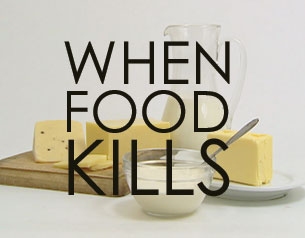When Food Kills
It's every parent's worst nightmare. One moment their child is perfectly healthy. The next, they've stopped breathing and are turning blue.
 It's every parent's worst nightmare. One moment their child is perfectly healthy. The next, they've stopped breathing and are turning blue. For many children, the merest hint of nut is all it takes to send them into anaphylactic shock. Food allergies are on the increase and the number of children affected has more than doubled in the past ten years. Yet simple precautions could significantly cut the death rate. This week's documentary, 'When Food Kills' is a wake up call to the rising danger of food allergies.
It's every parent's worst nightmare. One moment their child is perfectly healthy. The next, they've stopped breathing and are turning blue. For many children, the merest hint of nut is all it takes to send them into anaphylactic shock. Food allergies are on the increase and the number of children affected has more than doubled in the past ten years. Yet simple precautions could significantly cut the death rate. This week's documentary, 'When Food Kills' is a wake up call to the rising danger of food allergies.
It started out as just a normal day for Sophia Neou. Her seven year old son was at play camp; fun and games were the order of the day. Then she received a phone call from a teacher crying, telling her "He's turning blue and has stopped breathing." The paramedic witnessed his rapid decline. "He developed shortness of breath. He got very anxious and then his airways started to swell and that's when he passed out." When the helicopter arrived William was within 30 seconds of dying but they managed to bring him back.
Other families are not so lucky. "There's a big hole in our family and his name is Johnny," laments Cheryl Whitburn. Her 15 year old son died six years ago after accepting some rice from friends that had satay sauce on it. The tiny amount of peanut in the sauce was all that was needed to trigger a reaction. While cases like this are rare, the incidents of severe food allergies are increasing. "In the past ten to twenty years, the incidence of severe food allergies has doubled or tripled," stated Dr Alyson Kakakios from Westmead Children's hospital.
No one knows why allergies are on the increase. Scientists still don't know exactly what causes them. But it's generally thought that a combination of genetic predisposition and environmental factors make some children more susceptible than others. "Environmental influences are actually driving the immune systems of young children down the allergic pathway," explains Dr Alyson Kakiois. Children aren't getting exposure to the right bacteria which help their immune systems develop and protect them from allergies.
With no available 'cure' for allergies, parents have to strictly manage their children's condition. But a dangerous lack of knowledge among many doctors means they are often given the wrong information. Three year old Chantelle Markham nearly died after having a severe allergic reaction to egg. But when her doctor was told what had happened, he just said "You fed her egg too early. Feed her it again in six months," recalls Chantelle's mother. Luckily, her parents sought a second opinion. Other children have had their allergies misdiagnosed as croup.
Anaphylaxis occurs when an allergun such as egg or peanut is ingested. "The immune system goes into overdrive. Antibodies believe the allergen is an enemy invader, and they trigger a major defensive reaction, releasing masses of chemicals into the tissues to try and protect the body, causing inflamation," explains Dr Alyson Kakiois. When the throat becomes inflamed an allergy is transformed from an irritation, to a serious life threat. Dr Jane Peake likens the effect to an avalanche "with the snow coming down the mountain, and you don't know when the snow is going to stop". Once it approaches the village at the bottom "there comes a point at which there is almost nothing that you can do."
The legacy of allergies is often heartbreaking. The reaction is quick and unexpected, able to take away loved ones within minutes and ensure shock and grief for those that are left behind. Keah and Caitlin never got to know their mum before she suffered from a reaction. She is still alive, but has not spoken in ten years, is fed from a tube, and lives in a nursing home. Her husband "thought she was going to die. And now I wish she had." Tragedies such as this will not be averted until people wake up to the dangers that the food they eat can pose.
C9
FULL SYNOPSIS
